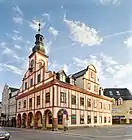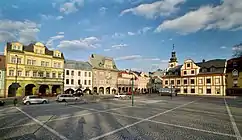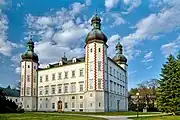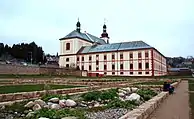Vrchlabí | |
|---|---|
 Aerial view with the Vrchlabí Castle on the left | |
 Flag  Coat of arms | |
 Vrchlabí Location in the Czech Republic | |
| Coordinates: 50°37′40″N 15°36′37″E / 50.62778°N 15.61028°E | |
| Country | |
| Region | Hradec Králové |
| District | Trutnov |
| First mentioned | 1359 |
| Government | |
| • Mayor | Jan Sobotka |
| Area | |
| • Total | 27.65 km2 (10.68 sq mi) |
| Elevation | 477 m (1,565 ft) |
| Population (2023-01-01)[1] | |
| • Total | 12,205 |
| • Density | 440/km2 (1,100/sq mi) |
| Time zone | UTC+1 (CET) |
| • Summer (DST) | UTC+2 (CEST) |
| Postal code | 543 01 |
| Website | www |
Vrchlabí (Czech pronunciation: [ˈvr̩xlabiː]; German: Hohenelbe, Latin: Albipolis) is a town in Trutnov District in the Hradec Králové Region of the Czech Republic. It has about 12,000 inhabitants. It lies at the foot of the Giant Mountains on the river Elbe. The town centre with the castle complex, monastery complex and town park is well preserved and is protected by law as an urban monument zone.
Administrative parts
Vrchlabí is made up of town parts of Vrchlabí, Hořejší Vrchlabí and Podhůří.
Etymology
The name of the town is closely related with the location on the river Elbe, the oldest name is Latin Albipolis (Albi = Elbe, polis = city). Both Czech and German name can be translated as Upper Elbe Area.[2]
Geography
Vrchlabí is located about 21 km (13 mi) northwest of Trutnov and 48 km (30 mi) north of Hradec Králové. About half of the municipal territory lies in the Giant Mountains, and its northern part lies in the Krkonoše National Park. The seat of the administration of the national park is located in Vrchlabí. The southern part of Vrchlabí lies in the Giant Mountains Foothills. The town is nicknamed the "Gateway to the Giant Mountains".[3] The highest point is on the slopes of the mountain Žalý with an altitude of about 1,026 metres (3,366 ft), however both its peaks lies behind the border of Vrchlabí.
Vrchlabí is located on the upper part of the river Elbe. There are two small ponds in the area, the larger one is Vejsplachy, used for recreational purposes. The Vrchlabský Pond, named after the town, lies outside the municipal territory.
History

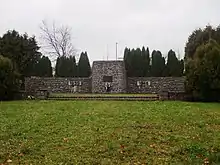
14th–16th centuries
The history of Vrchlabí started with the colonization of the Giant Mountains. The first settlement called Wrchlab was probably founded before 1300. The first written mention is from 1359.[2]
The most significant person in the history Vrchlabí was Kryštof Gendorf, a mining expert who developed the town into one of the most important metallurgy centres. Thanks to him, Vrchlabí was granted town rights in 1533, along with two annual fairs. Many people from German speaking lands came to work and live to the town during his reign and brought in the Lutheran reformation faith, which spread quickly in the region, supported vividly by Gendorf himself. Vrchlabí also became a place of fairs at that time. Especially linen cloth was highly desired and it was exported into Italy or Spain, as well North Africa.[2]
In 1561, the estate was acquired by Gendorf's daughter Eustachia. She had three daughters, Barbora, Kateřina and Rozina, among whom the Vrchlabí estate was divided after her death in 1568, but in the end the entire estate was acquired by Rozina and her husband Vilém Miřkovský of Stropčice. At that time, flax weaving became another important industry for Vrchlabí. The weaving guild was founded in Vrchlabí in 1590, at the time of the town's greatest growth.[2][4]
17th–20th centuries
In 1624, Albrecht von Wallenstein bought the estate from Vilém Miřkovský of Stropčice Jr. During the Thirty Years' War, the smelters in Vrchlabí became an important supplier of weapons. After Wallenstein's death in 1634, Emperor Ferdinand II donated the estate to Rudolf of Morzin. The Counts of Morzin owned Vrchlabí until 1881.[2]
Vrchlabí was known for manufacturing of organs in the 17th and 18th centuries, which was introduced into the town by the Tauchmann family.[5] Textile production dominated the town's economy from the late 18th century until the 1930s and determined the industrial and craft development of Vrchlabí.[2]
In 1867, winter sports started to develop in the region. The main promoter of skiing was Guido Rotter, a local factory owner.[2]
The town was part of the Kingdom of Bohemia, which itself fell to the Habsburg monarchy in the 16th century, and from 1867 to 1918 was included in Austria-Hungary. Administratively it was head of the Hohenelbe District, one of the 94 Bezirkshauptmannschaften in Bohemia.[6]
In 1918, Vrchlabí became part Czechoslovakia, when the Czechs regained independence. From 1938 to 1945 it was occupied by Germany, and was then administered as part of the Reichsgau Sudetenland. During the occupation, the Germans established and operated a Gestapo prison in the town,[7] and a subcamp of the Gross-Rosen concentration camp for female prisoners in the Hořejší Vrchlabí town part.[8] Nazi Germany also brought many Italian, French, English and Russian prisoners of war to work as forced laborers in the town.[9] The town's Germans who had not fled in World War II were expelled according to the Potsdam Agreement and Beneš decrees. The town was restored to Czechoslovakia.
Demographics
|
|
| ||||||||||||||||||||||||||||||||||||||||||||||||||||||
| Source: Censuses[10][11] | ||||||||||||||||||||||||||||||||||||||||||||||||||||||||
Economy
Since the 16th century, Vrchlabí is an industrial town. Nowadays, it is known especially for machinery industry. In Vrchlabí there is one of three factories of Škoda Auto in the Czech Republic. The local branch employs about 1,000 people. From 1946 to 2012, it produced cars, and since 2015, it produces components for cars.[12] The largest employer with its headquarters in the town is ARGO-HYTOS, producer of components and systems for the hydraulic industry.[13]
Vrchlabí is also known as centre of tourism and winter sports, which significantly contribute to the town's economy.[3]
Transport
Vrchlabí is the terminus of a railway line heading from Trutnov.[14]
Culture
The beer festival Krkonošské pivní slavnosti ("Giant Mountains Beer Festival") has been held in the town every year since 1998.[15]
The Střelnice house is the centre of culture. It is a place where all concerts, plays or balls are performed.
Sport
Krakonošova stovka is a 100 km-long march that has been held annually since 1966.[16]
The local ice hockey club, HC Stadion Vrchlabí, plays in the 2nd Czech Republic Hockey League since 2022–23 season.
The town has a rugby club called Vrchlabí Mad Squirrels.[17]
There are four ski resorts in the area: Kněžický Vrch, Kněžický Vrch – Kebrlák, Bubákov, and Herlíkovice.[18]
Sights
The Vrchlabí Castle was built in 1546–1548 for Kryštof Gendorf and originally surrounded by the moat. It was one of the first Renaissance castles in Bohemia. The most valuable monument in the castle and the last piece of the original equipment is the Renaissance faience stove. Nowadays the castle houses the municipal office and some of the spaces are freely accessible.[19]
The castle is surrounded by a park from the second half of the 19th century. It was originally an ornamental garden, but after the moat was eliminated, the park was redesigned. In the southwestern part of the park is the castle chapel with the Czernin-Morzin tomb. It was built in the Neo-Gothic style in 1887–1890.
The Discalced Augustinians Monastery was founded in 1705. The monastery complex with the Church of Saint Augustinus was built in the Baroque style with Neoclassical elements and was finished in 1725. Nowadays the premises of the monastery house an exhibition of the Krkonoše Museum on the nature and history of the region, and the church is often used as a concert hall due to its great acoustics.[19]
The Church of Saint Lawrence on the Míru Square was built in the Neo-Gothic style in 1889. It replaced an old Gothic church from the 14th century. It has 60 metres (200 ft)-high tower. Opposite the church is located a valuable set of four gabled houses where is located Krkonoše Museum and KRNAP infocentre. Next to them is one of the oldest monuments in the town, a house which served as the town hall from 1591 to 1737. Above the brick ground floor is the timbered floor supported by four sandstone columns with Ionian heads.[19]
The second square in the historic centre is T. G. Masaryka Square. Its main landmark is the New Town Hall from 1732–1737. It was originally built in the Baroque style as one of the first stone buildings in the town. In 1927, it was rebuilt to the Neorenaissance style.[20]
The very oldest house in Vrchlabí is the House with Seven Gables. It is a modified village chalet with unique appearance.[19]
Notable people
- Victor Kugler (1900–1989), Austrian-Dutch war hero
- Anton Joachimsthaler (born 1930), German historian
- Anna K (born 1965), singer
- Zdeněk Vítek (born 1977), biathlete and coach
- Veronika Vítková (born 1988), biathlete
- Michal Krčmář (born 1991), biathlete
- Karolína Erbanová (born 1992), long-track speed skater
- Eva Samková (born 1993), snowboarder, Olympic champion
Twin towns – sister cities
 Baunatal, Germany
Baunatal, Germany Kowary, Poland
Kowary, Poland Trouville-sur-Mer, France
Trouville-sur-Mer, France
References
- ↑ "Population of Municipalities – 1 January 2023". Czech Statistical Office. 2023-05-23.
- 1 2 3 4 5 6 7 "Historie" (in Czech). Město Vrchlabí. Retrieved 2023-06-14.
- 1 2 "About the Town". Město Vrchlabí. Retrieved 2021-09-22.
- ↑ Louda, Jiří; Zázvorková, Blanka (2006). Zmizelé Čechy – Vrchlabí (in Czech). Paseka. pp. 11–12. ISBN 80-7185-757-2.
- ↑ Tomíček, Jan (2010). "Varhanářská manufaktura ve Vrchlabí". Varhany a jejich osudy (in Czech). PM Vydavatelství. ISBN 978-80-900808-2-9.
- ↑ Die postalischen Abstempelungen auf den österreichischen Postwertzeichen-Ausgaben 1867, 1883 und 1890, Wilhelm Klein, 1967
- ↑ "Gestapogefängnis Hohenelbe". Bundesarchiv.de (in German). Retrieved 10 September 2020.
- ↑ "Subcamps of KL Gross- Rosen". Gross-Rosen Museum in Rogoźnica. Retrieved 10 September 2020.
- ↑ Sula, Dorota (2010). "Jeńcy włoscy na Dolnym Śląsku w czasie II wojny światowej". Łambinowicki rocznik muzealny (in Polish). Opole. 33: 66.
- ↑ "Historický lexikon obcí České republiky 1869–2011 – Okres Trutnov" (in Czech). Czech Statistical Office. 2015-12-21. pp. 17–18.
- ↑ "Population Census 2021: Population by sex". Public Database. Czech Statistical Office. 2021-03-27.
- ↑ "Závod společnosti ŠKODA AUTO ve Vrchlabí: High-tech závod na úpatí Krkonoš" (in Czech). ŠKODA AUTO a.s. 2019-10-10. Retrieved 2021-09-22.
- ↑ "About Us". ARGO-HYTOS s.r.o. Retrieved 2021-09-22.
- ↑ "Detail stanice Vrchlabí" (in Czech). České dráhy. Retrieved 2023-06-14.
- ↑ "Krkonošské pivní slavnosti" (in Czech). Krkonošské pivní slavnosti. Retrieved 2022-10-04.
- ↑ "O Krakonošově stovce" (in Czech). Krakonošova stovka. Retrieved 2022-10-04.
- ↑ "Home" (in Czech). Vrchlabí Mad Squirrels. Retrieved 2023-06-14.
- ↑ "Skiareál Vrchlabí" (in Czech). Destinační společnost pro turistickou oblast Krkonoše. Retrieved 2022-10-04.
- 1 2 3 4 "Tourist Attractions". Město Vrchlabí. Retrieved 2021-09-23.
- ↑ "Radnice ve Vrchlabí" (in Czech). Liberec Region. Retrieved 2021-09-23.
- ↑ "Partnerská města" (in Czech). Město Vrchlabí. Retrieved 2023-12-16.
External links
- Official website
- Official tourist portal
- Information about Vrchlabí in the Krkonoše Mountains
- Information about the 1938–1945 history (in German)
